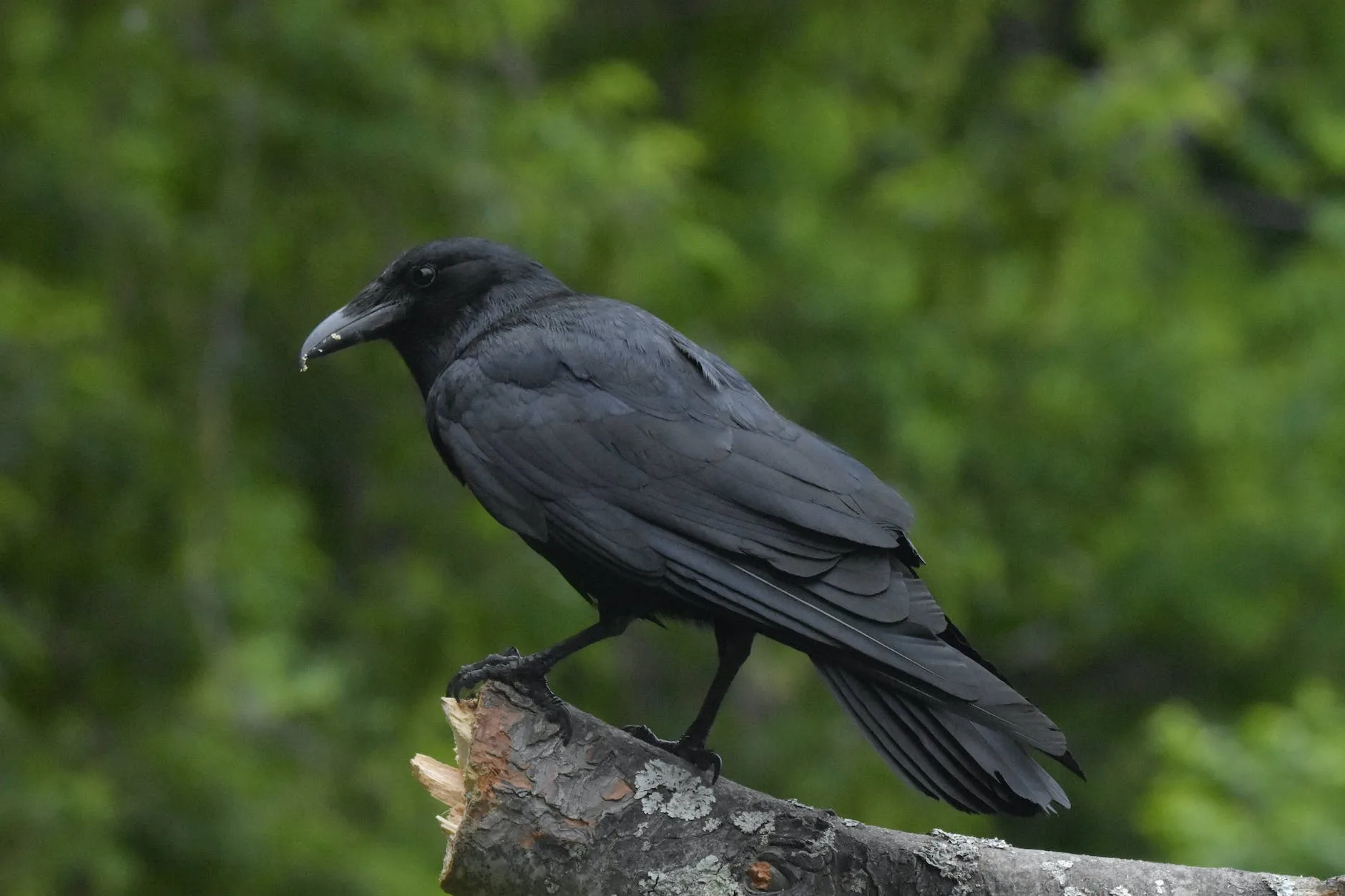Unveiling the Elegance: The Slender-Billed Crow of Malaysia and Beyond
December 29, 2023 | by BlackCrow.com

Introducing the Slender-Billed Crow
The Slender-Billed Crow, scientifically known as Corvus enca (Horsfield, 1821), is a remarkable bird species that captures the attention of bird enthusiasts and nature lovers alike. Let’s take a closer look at this fascinating crow and its classification and distribution.
Overview of the Slender-Billed Crow
The Slender-Billed Crow is a medium-sized bird belonging to the Corvidae family, which includes other intelligent and social birds like ravens and magpies. This crow species is predominantly found in Malaysia, the Philippines, Borneo, and Indonesia.
With its sleek and slender appearance, the Slender-Billed Crow stands out among other crow species. Its black feathers have a glossy sheen, giving it an elegant and eye-catching appearance. While it shares some similarities with other crow species, the Slender-Billed Crow has distinct physical characteristics that set it apart.
Classification and Distribution
The Slender-Billed Crow belongs to the genus Corvus, which encompasses various crow species found worldwide. Within the genus, it falls into the species Corvus enca. The specific name “enca” refers to its slender bill, which is a defining characteristic of this crow.
This crow species is primarily distributed across Malaysia, the Philippines, Borneo, and Indonesia. Its habitat includes diverse environments such as forests, woodlands, and agricultural areas. The range of the Slender-Billed Crow overlaps with other crow species, but it has its own unique distribution pattern.
To learn more about other crow species, you can explore our articles on pied crow, white-necked raven, American crow, and little crow.
The Slender-Billed Crow’s unique characteristics, along with its classification and distribution, make it a captivating species to study and appreciate. As we delve deeper into its physical characteristics, habitat, behavior, and conservation status, we will gain a deeper understanding of the elegance and significance of this remarkable bird.
Physical Characteristics
The slender-billed crow, scientifically known as Corvus enca, is a remarkable bird with distinct physical characteristics that set it apart from other members of the crow family. Let’s explore the size, appearance, and notable features of this elegant bird.
Size and Appearance
The slender-billed crow is a medium-sized bird, measuring approximately 40-46 centimeters (16-18 inches) in length. It has a slender body shape and long wings, which enable it to maneuver gracefully through the air. The overall coloration of this crow is predominantly black, with a glossy sheen that adds to its elegance.
One distinguishing feature of the slender-billed crow is its slender, slightly curved bill. The name “slender-billed” accurately describes this crow’s distinctive beak, which sets it apart from other crow species. The bill is relatively long and tapers to a fine point, allowing the bird to probe into crevices and forage for food effectively. The upper mandible of the bill is black, while the lower mandible is grayish-black.
Notable Features
While the slender-billed crow shares some similarities with other members of the crow family, it possesses a few notable features that make it unique. One such feature is its striking blue eyes. The vibrant blue coloration of the eyes contrasts beautifully against the bird’s black plumage.
Another notable feature of the slender-billed crow is its vocalization. These birds produce a variety of calls, including cawing sounds, soft rattles, and croaking notes. These vocalizations play a significant role in communication among the members of the crow community, helping them establish territories and maintain social bonds.
It’s important to note that the physical characteristics of the slender-billed crow may vary slightly depending on its geographical distribution. The slender-billed crow can be found in Malaysia, the Philippines, Borneo, and Indonesia. Variation in size and appearance may occur in different populations across its range.
Understanding the physical characteristics of the slender-billed crow allows us to appreciate its unique beauty and distinguish it from other members of the crow family. By delving deeper into the habitat, behavior, and conservation status of these birds, we can gain a comprehensive understanding of their role in the natural world.
Habitat and Behavior
The slender-billed crow, scientifically known as Corvus enca, is a fascinating species with distinct habitat preferences and behavioral characteristics.
Natural Habitat
The slender-billed crow is primarily found in Malaysia, the Philippines, Borneo, and Indonesia. Within these regions, it inhabits various types of habitats, including forests, woodlands, mangroves, and coastal areas. These adaptable birds have also been sighted in urban environments, demonstrating their ability to thrive in a range of settings.
Social Behavior and Diet
Slender-billed crows are highly sociable birds and are often observed in small to large groups called flocks. These flocks play a crucial role in their feeding behaviors, as they forage together in search of food. The slender-billed crow has an omnivorous diet, feeding on a diverse range of food sources. Their diet typically includes fruits, seeds, insects, small reptiles, and even carrion.
These crows have a remarkable intelligence and problem-solving ability, which is evident in their foraging behaviors. They have been observed using tools to extract food from hard-to-reach places, showcasing their ingenuity. Additionally, slender-billed crows are known to engage in cooperative feeding, where members of the flock work together to obtain food.
To protect themselves from potential predators, slender-billed crows are highly vigilant and utilize warning calls to alert other members of the flock. This behavior helps to ensure the safety and well-being of the group as a whole.
Understanding the natural habitat and social behavior of the slender-billed crow provides valuable insight into the ecological role they play in their respective ecosystems. By studying their behaviors and habitat preferences, conservation efforts can be better tailored to protect and preserve this unique species.
Conservation Status
The conservation status of the Slender-Billed Crow is of significant concern due to various threats it faces in its natural habitat. Understanding these threats and the conservation efforts in place is crucial for the preservation of this unique bird species.
Threats to the Slender-Billed Crow
The Slender-Billed Crow (Corvus enca) is primarily found in Malaysia, the Philippines, Borneo, and Indonesia. Despite its wide distribution, the species faces several threats that impact its population and habitat. These threats include:
- Habitat Loss: Rapid deforestation and urbanization pose a significant threat to the Slender-Billed Crow’s natural habitat. The destruction of forests and conversion of land for agricultural purposes reduces the availability of suitable nesting and foraging areas for the crows.
- Illegal Logging: Illegal logging activities have detrimental effects on the Slender-Billed Crow’s habitat. Unregulated logging not only destroys crucial nesting sites but also disrupts the ecological balance, leading to a decline in food sources for the crows.
- Pollution and Climate Change: Pollution, particularly from industrial activities, can have adverse effects on the Slender-Billed Crow’s health and overall ecosystem. Additionally, climate change and its associated impacts, such as rising temperatures and altered rainfall patterns, can disrupt the crow’s breeding and foraging behaviors.
- Hunting and Poaching: Although illegal, hunting and poaching of the Slender-Billed Crow still occur in certain areas. These activities, driven by factors such as superstitions and the illegal wildlife trade, further endanger the species and contribute to its declining population.
Conservation Efforts
Efforts are underway to protect and conserve the Slender-Billed Crow and its habitat. Conservation organizations, local communities, and government agencies are working together to implement various initiatives, including:
- Protected Areas: Establishing protected areas and nature reserves helps safeguard the Slender-Billed Crow’s habitat from further degradation. These protected areas provide a safe haven for the crows, ensuring the preservation of their nesting and foraging sites.
- Habitat Restoration: Restoration projects focus on reforesting areas that have been impacted by deforestation and habitat loss. By replanting native tree species and creating suitable habitats, these efforts aim to restore the ecological balance necessary for the survival of the Slender-Billed Crow.
- Community Engagement: Engaging local communities in conservation efforts is crucial for the long-term success of protecting the Slender-Billed Crow. Education and awareness programs are conducted to promote understanding and appreciation for the species, encouraging community participation in conservation activities.
- Legislation and Enforcement: Governments and conservation organizations are working to strengthen legislation and enforcement measures to combat illegal logging, hunting, and poaching. Strict penalties and increased surveillance help deter illegal activities that threaten the Slender-Billed Crow’s survival.
The combined efforts of these conservation initiatives are essential in ensuring the long-term survival and well-being of the Slender-Billed Crow. Continued monitoring and research are necessary to assess the effectiveness of these efforts and to adapt conservation strategies as needed. By raising awareness and actively working towards the protection of this unique species, we can contribute to the conservation of the Slender-Billed Crow and its delicate ecosystem.
Cultural Significance
The Slender-Billed Crow holds cultural significance in various aspects, including folklore, mythology, and conservation awareness and education.
Folklore and Mythology
Throughout history, crows have often been associated with myths, legends, and folklore in different cultures around the world. The Slender-Billed Crow, with its unique characteristics, has also found its place in these tales.
In some cultures, crows are considered symbols of wisdom and intelligence.
The Slender-Billed Crow’s distinct appearance and behavior have sparked the imagination of storytellers, leading to its inclusion in traditional stories and myths.
Conservation Awareness and Education
Beyond folklore and mythology, the Slender-Billed Crow plays a crucial role in conservation awareness and education efforts. As a species that faces various threats, raising awareness about its conservation needs is essential.
Educational programs and initiatives highlight the importance of protecting the habitat and ensuring the survival of the Slender-Billed Crow. By sharing information about its natural history, behavior, and conservation status, individuals and organizations work together to promote a deeper understanding of this remarkable bird.
Conservation efforts include habitat restoration, establishing protected areas, and implementing measures to mitigate the threats faced by the Slender-Billed Crow. These initiatives aim to ensure the long-term survival of the species and maintain its ecological role within its ecosystem.
By fostering a sense of appreciation and understanding for the Slender-Billed Crow, conservation awareness and education contribute to the broader goal of preserving biodiversity and protecting our natural heritage.
The Slender-Billed Crow’s cultural significance extends beyond folklore and mythology, serving as a symbol of conservation efforts and inspiring individuals to take action to safeguard its future. Through education and awareness, we can all contribute to the preservation of this remarkable bird and the ecosystems it inhabits.
RELATED POSTS
View all


